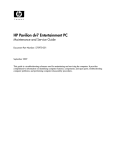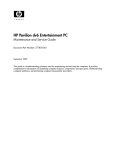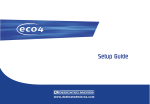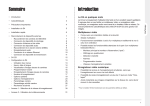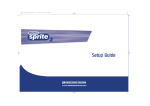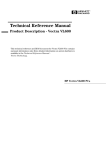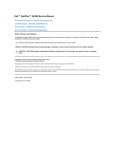Download HP Vectra XE320 Technical information
Transcript
product description hp vectra xe320 technical reference manual hp desktop pcs www.hp.com/go/vectrasupport Notice The information contained in this document is subject to change without notice. Hewlett-Packard makes no warranty of any kind with regard to this material, including, but not limited to, the implied warranties of merchantability and fitness for a particular purpose. Hewlett-Packard shall not be liable for errors contained herein or for incidental or consequential damages in connection with the furnishing, performance, or use of this material. This document contains proprietary information that is protected by copyright. All rights are reserved. No part of this document may be photocopied, reproduced, or translated to another language without the prior written consent of Hewlett-Packard Company. Microsoft® and Windows® are U.S. registered trademarks of Microsoft Corporation. Adobe®, Acrobat® and Acrobat® Reader™ are trademarks or registered trademarks of Adobe Systems Incorporated. NVIDIA™, TNT™ and Vanta™ are trademarks of NVIDIA Corporation. ATI™ is a trademark of ATI Technologies Inc. Intel® and Pentium® are registered trademarks of Intel Corporation. Analog Devices® is a registered trademark of Analog Devices Incorporated. HP France Business Desktop Division 38053 Grenoble Cedex 9 France © 2002 Hewlett-Packard Company Information Roadmap Use the icon in Acrobat Reader to search for information in this PDF. The following types of information are available for HP Business PCs: Technical Reference See the HP Technical Reference Manuals. This Technical Reference Manual is a technical reference and BIOS document for personnel providing system level support. It is available in PDF format on the HP support web site (www.hp.com/go/vectrasupport or www.hp.com/go/e-pcsupport). It is presented in modular form to provide quick and easy access to technical information on the HP Business PC. It is made up of the following components: • The Introduction & HP Business PC Overview provides a quick reference guide to the hardware components and BIOS used in the latest HP Business PCs. It also lists some of the available accessories. • Product Description (this document). Provides technical information specific to a HP Business PC. This includes summary information on product hardware and detailed information on the BIOS. Read this manual to see which hardware components are in the PC. • HP Business PC Technology. Provides an in-depth guide to the hardware in all of the featured HP Business PCs. Subjects covered include chipsets, processors, graphics controllers, hard disk drives and optical drives. Installing, Configuring and Upgrading See the HP Upgrade Guide or the HP Service Handbook Chapter . The Upgrade Guide will help you upgrade and replace components in your HP Business PC, including the hard drive, memory, battery, power supply, and optical drives. More information is available on the HP support web site (www.hp.com/go/vectrasupport). The Service Handbook Chapter, available in PDF format on the HP support web site (www.hp.com/go/vectrasupport or www.hp.com/go/e-pcsupport), provides information on: • HP Business PC configurations • Replacement parts • Available accessories. Troubleshooting See the HP Troubleshooting Guide. The Troubleshooting Guide, available in PDF format on the HP support web site (www.hp.com/go/vectrasupport or www.hp.com/go/e-pcsupport) will help you: • Troubleshoot your HP Business PC • Find out where to get more information. XE320 product description 3 Discover and use your product See the HP Quick Start card and HP Quick User’s Guide. The Quick Start card provided with your HP Business PC will help you: • Set up and begin using your HP Business PC for the first time • Upgrade and replace components in your HP Business PC, including the hard drive, processor memory, add-on cards and optical drives. More information is available on the HP support web site (www.hp.com/go/vectrasupport or www.hp.com/go/e-pcsupport). • Find out where to get more information. The Quick User’s Guide provided with your HP Business PC includes basic troubleshooting information, technical specifications, warranty and legal information. Your computer’s online information Your computer may contain online help information on the hard disk. It includes information on: • Troubleshooting and how to use HP Instant Support • Linking to useful HP web sites. Information on the hp support web site Refer to the HP support web site (www.hp.com/go/vectrasupport or www.hp.com/go/e-pcsupport) for a wide range of information, including: • Downloadable documentation • Service and support options • The latest BIOS, drivers and utilities • Answers to Frequently Asked Questions. System recovery cd-roms Used for a full system recovery or alternative OS installation. Includes instructions on how to recover your preloaded software including operating system, drivers and utilities. 4 XE320 product description Finding Information Use the following table to determine where to locate particular types of information: Type of Information • Support phone numbers Location Quick User’s Guide Technical support contact information • Warranty information • • How to set up your computer Quick Start Card (details) Quick User’s Guide (general information) • Operation of your computer Operating system and application manuals • Diagrams and detailed instructions on installing add-on devices • Internal wire connections for adding hard drives, CD-ROM, etc. • Memory expansion and replacing devices Upgrade Guide (desktop PCs only) Identifying the problem • Information on errors • Problem solving Troubleshooting Guide • • Troubleshooting • Parts list • Accessories list Service Handbook Chapter BIOS • Connectors • LAN controller Technical Reference Manual (this document) • IRQ • POST setup • Specifications • System board layout • Technical diagrams • XE320 product description 5 Bibliography Datasheets and other information can be obtained at: ❒ Intel Chipsets developer.intel.com ❒ Pentium 4 Processors www.intel.com/pentium4 ❒ Analog Devices AD1885 www.analogdevices.com ❒ Intel LAN card www.intel.com/support/network ❒ ATI Rage 128 Pro graphic card www.ati.com ❒ NVIDIA graphic cards www.nvidia.com ❒ Hewlett-Packard white papers are available on a variety of subjects including AGP graphics and SDRAM memory at: www.hp.com/go/library 6 XE320 product description Table of Contents System Overview Package Features . . . . . . . . . . . . . . . . . . . . . . . . . . . . . . 10 Front Panel . . . . . . . . . . . . . . . . . . . . . . . . . . . . . . . . . . . . 10 Rear Connectors . . . . . . . . . . . . . . . . . . . . . . . . . . . . . . . . 11 Inside the Computer . . . . . . . . . . . . . . . . . . . . . . . . . . . . . . 12 Specifications . . . . . . . . . . . . . . . . . . . . . . . . . . . . . . . . . 13 Physical Characteristics. . . . . . . . . . . . . . . . . . . . . . . . . . . 13 Environmental Specifications . . . . . . . . . . . . . . . . . . . . . . . 13 System Features XE320 System Board Layout . . . . . . . . . . . . . . . . . . . . . 16 System Board Components . . . . . . . . . . . . . . . . . . . . . . . . 17 Architectural View . . . . . . . . . . . . . . . . . . . . . . . . . . . . . 18 Main Memory . . . . . . . . . . . . . . . . . . . . . . . . . . . . . . . . . 19 Processors . . . . . . . . . . . . . . . . . . . . . . . . . . . . . . . . . . . 19 System Board Switches . . . . . . . . . . . . . . . . . . . . . . . . . 19 Accessory Board Slots . . . . . . . . . . . . . . . . . . . . . . . . . . 20 Mass Storage Devices. . . . . . . . . . . . . . . . . . . . . . . . . . . 21 Hard Disk Drives . . . . . . . . . . . . . . . . . . . . . . . . . . . . . . . . 21 Floppy Disk Drives . . . . . . . . . . . . . . . . . . . . . . . . . . . . . . . 21 Optical Drives . . . . . . . . . . . . . . . . . . . . . . . . . . . . . . . . . . 21 Graphics . . . . . . . . . . . . . . . . . . . . . . . . . . . . . . . . . . . . . 26 Nvidia TNT2 Vanta Graphics Card . . . . . . . . . . . . . . . . . . . 26 ATI Rage 128 Pro Graphics Card . . . . . . . . . . . . . . . . . . . . 26 Audio . . . . . . . . . . . . . . . . . . . . . . . . . . . . . . . . . . . . . . . 27 Adding an Audio Accessory Board . . . . . . . . . . . . . . . . . . . 27 Network . . . . . . . . . . . . . . . . . . . . . . . . . . . . . . . . . . . . . 28 LAN Connector. . . . . . . . . . . . . . . . . . . . . . . . . . . . . . . . . . 28 XE320 product description 7 BIOS Overview BIOS Summary . . . . . . . . . . . . . . . . . . . . . . . . . . . . . . . . 30 Setup Program Menus . . . . . . . . . . . . . . . . . . . . . . . . . . . . 31 Power Saving . . . . . . . . . . . . . . . . . . . . . . . . . . . . . . . . . 31 BIOS Addresses . . . . . . . . . . . . . . . . . . . . . . . . . . . . . . . 32 System Memory Map . . . . . . . . . . . . . . . . . . . . . . . . . . . . . 32 HP I/O Port Map (I/O Addresses Used by the System) . . . . . 32 POST Tests . . . . . . . . . . . . . . . . . . . . . . . . . . . . . . . . . . 36 HP e-DiagTools Preboot Diagnostics (Beep Codes) . . . . . 40 Drivers and Software Drivers . . . . . . . . . . . . . . . . . . . . . . . . . . . . . . . . . . . . . . 42 Software . . . . . . . . . . . . . . . . . . . . . . . . . . . . . . . . . . . . 42 Operating System . . . . . . . . . . . . . . . . . . . . . . . . . . . . . . . 42 Software . . . . . . . . . . . . . . . . . . . . . . . . . . . . . . . . . . . . . . 42 e-DiagTools . . . . . . . . . . . . . . . . . . . . . . . . . . . . . . . . . . . . 42 BIOS Updates . . . . . . . . . . . . . . . . . . . . . . . . . . . . . . . . . 42 8 XE320 product description Status 1 System Overview This chapter introduces the internal and external features, and lists the specifications of HP Vectra XE320 PCs. System Overview Package Features Front Panel Optical disk activity light (green) Floppy disk activity light (red) Power on status light (green) On/Off power button 10 XE320 product description Hard disk drive activity light (yellow) System Overview Rear Connectors Voltage switch Power connector Mouse Keyboard 25-pin Parallel Connector Serial Connectors Line Out Line In Microphone 2 USB Connectors Network (LAN) connector Monitor Connector XE320 product description 11 System Overview Inside the Computer Processor CD-ROM, CD-RW drive, or DVD drive Power supply Floppy disk drive Hard disk drive Main memory Accessory board slots Note: Hard disk and floppy disk cables have been removed for picture clarity 12 XE320 product description System Overview Specifications Physical Characteristics Vectra XE320 Characteristics Weight (configuration with 1 CD-ROM drive, excluding keyboard and display) 10 kilograms (22 pounds) Dimensions 38.0 cm (Depth) by 21.0 cm (Width) by 39.0 cm (Height) (14.96 inches by 8.27 inches by 15.35 inches) Footprint 0.068 m2 (0.73 sq ft) Acoustic noise emission (ISO 7779) Sound pressure level at operator position Operating (idle) LpA ≤ 35 dBA Power Supply NOTE Input voltage (voltage selection switch): 100-127 V 6A max, 200-240 V 3A max Input frequency: 50/60Hz Power consumption (115 / 60Hz and 230 / 50 Hz) Windows XP Max operating 110W Idle (typical) 45W Suspend ≤ 4W Off ≤ 4W The power consumption and acoustics figures given in the table above are valid for the standard configuration as shipped. For more information, refer to the product’s data sheet at HP’s web site: www.hp.com/desktops. When the computer is turned off with the power button on the front panel, the power consumption falls below 10W, but it is not zero. The special on/off method used by this computers considerably extends the lifetime of the power supply. To reach zero power consumption in “off” mode, either unplug the power outlet or use a power block with a switch. Environmental Specifications Environmental Specifications (System Processing Unit, with Hard Disk) NOTE Operating Temperature +10°C to +35°C (+50°F to 95°F) Storage Temperature -40°F to +70°F (-40°C to +158°C) Operating Humidity 15% to 80% (relative) Storage Humidity 8% to 85% (relative), non-condensing at 40°C (104°F) Operating Altitude 10000ft (3100m) max Storage Altitude 15000ft (4600m) max Operating temperature and humidity ranges may vary depending on the mass storage devices installed. High humidity levels can cause improper operation of disk drives. Low humidity ranges can aggravate static electricity problems and cause excessive wear of the disk surface. XE320 product description 13 System Overview 14 XE320 product description Status 2 System Features This chapter describes core components of HP Vectra XE320 PCs such as processors, chipsets, mass storage devices, graphics controllers, audio controllers, network features and input devices. System Features XE320 System Board Layout The HP Vectra XE320 PC system board features a Socket 478B for a Pentium 4 processor, three DIMM main memory slots, three PCI slots and one AGP slot. 16 XE320 product description System Features System Board Components The following diagram shows where the different slots and connectors are located on the system board: Internal speaker connector (unused) CD audio connector AGP Slot (for AGP card) Microphone-in Line-in LAN 2 x USB Line-out Parallel 2 x Serial Keyboard Mouse System fan connector PCI Slot 1 Power connector PCI Slot 2 Processor socket (see page 19) PCI Slot 3 Heat sink covering Intel 845 chipset CPU fan connector Battery DIMM1 DIMM2 DIMM3 Floppy connector Status panel connectors IDE connectors Battery Switch block (see page 19) WARNING Power supply connector There is a risk of explosion if the battery is not replaced by the correct type. Make sure you dispose of used batteries according to instructions provided. XE320 product description 17 System Features Architectural View The following diagram shows the XE320 Intel 845 Chip architecture: Pentium 4 processor System Bus 3.2GB/s Memory Bus AGP graphics card Intel 845 AGP Slot AGP 4X 1066MB/s Main Memory 133MHz SDRAM Hard Disk ICH2 chip 2 USB Ports 3 PCI Slots Optical drive PCI Bus Audio AD1885 Super I/O Flash BIOS Serial/Parallel/FDD/PS2 18 XE320 product description Integrated Intel Pro/100 VE Network Adapter (10 Base-T/100 Base-TX LAN Interface) System Features Main Memory DIMM slots There are three 168-pin DIMM slots on the system board for installing main memory. You can install 133MHz SDRAM modules, these are available in 128, 256 and 512MB memory modules. 64MB memory modules are not supported. You can install a maximum of 1.5GB (3 x 512MB modules). You can only use non-ECC memory modules. Processors 478B PGA Socket The XE320 is equipped with a socket 478B Intel Pentium 4 processor. The processor is connected to the system board through a Pin Grid Array (PGA) 478B Socket. A heatsink and fan (not shown) cover the processor to prevent it from overheating. To find out more about Pentium 4 technology, refer to the Technical Reference Manual - HP Business PC Technology. System Board Switches The following table gives the functionality and default position of switches on the system board switch block: System Board switches Switch Default Position Function 1-4 OFF Reserved 5 OFF ON = Clear CMOS 6 OFF ON = Clear Password 7 OFF ON = BIOS crisis mode recovery 8 OFF Not used 9 ON OFF = Boot block FLASH protect 10 OFF Not used XE320 product description 19 System Features Accessory Board Slots The XE320 has four accessory board slots: three PCI slots and one 1.5V AGP slot. AGP The PCI slots are PCI 2.2 compliant and each slot supports a maximum total current of 375 mA. Your graphics card is installed in the AGP slot. The 1.5V AGP slot is backward compatible with AGP 1x, 2x and 4x modes. A latch on one end of the AGP slot locks the graphics card in place. PCI 1 PCI 2 PCI 3 PCI Slot Numbers Your PC uses logical slot numbers in the BIOS Setup program. You need to know these logical slot numbers if you want to change the PCI slot configuration in the Setup program. XE320 PCI Mapping Table Slot# Bus Device PCI Device 0 0 MCH: Host bridge 0 2 MCH: AGP bridge 0 30 ICH: Hub interface to PCI bridge 0 31 ICH: PCI to LPC bridge 0 31 ICH: IDE controller 0 31 ICH: USB controller 0 31 ICH: SMBUS controller 0 31 ICH: AC97 audio controller 2 9 PCI slot 1 1 2 10 PCI slot 2 2 2 11 PCI slot 3 3 1 0 AGP device AGP slot 1 8 LAN controller Embedded 20 XE320 product description System Features Mass Storage Devices Hard Disk Drives A 3.5-inch hard disk drive is supplied on an internal shelf in some models. These hard drives can be provided with the PC. To see which other hard disk drives can be purchased as accessories for the XE320, refer to www.hp.com/desktops/products/accessories. 20GB Ultra-ATA 100 40GB Ultra-ATA 100 Average Seek Time (ms) 8.9 to 12.1 Track-to-Track Seek TIme (ms) 1.5 Full Stroke Seek Time (ms) 20 to 25 Rotational Speed (RPM) 5400 Buffer Size (MB) 2 To find out about Ultra-ATA 100 hard disk drive technology, refer to the Technical Reference Manual HP Business PC Technology. Floppy Disk Drives All models are supplied with a 3.5-inch floppy disk drive. Optical Drives Models may be fitted with a 48X Max-speed IDE CD-ROM drive. This drive can play standard CD-ROM discs, conforming to optical and mechanical standards as specified in the Red and Yellow Book. This drive can also be purchased as an accessory. Refer to: www.hp.com/desktops/products/accessories. To find out about CD-ROM and DVD drive technology, refer to the Technical Reference Manual - HP Business PC Technology. XE320 product description 21 System Features Features of the CD-ROM Drive (48X) Description Supported formats - CD-ROM Mode-1 data disc - CD-ROM Mode-2 data disc (Mode 1 and Mode 2) - Photo-CD Multisession - CD Audio disc - Mixed mode CD-ROM disc (data and audio) - CD-ROM XA - CD-I - CD-Extra - CD-R - CD-RW Disc Diameter 120 mm Data Block Size 2,055 bytes (14X, Mode-1) 4,800 bytes (32X, Mode-2) Storage Capacity 650MB (Mode-1) 742MB (Mode-2) Sustained Transfer Rate Outerside: 7.2MB/s Max (48X) Burst Transfer Rate PIO mode 4: 16.6 MB/s maximum Single Word DMA Mode 2: 8.3MB/s maximum Multi Word DMA Mode 2: 16.6MB/s maximum. Access Time Average Stroke (1 / 3 stroke): 110ms (typical) Full Stroke: 180ms (typical) Buffer Memory Size 128KB Rotational speed Approx. 11,100 rpm maximum 22 XE320 product description System Features Features of the CD-RW Drive (24X/10X/40X) Description Supported formats - CD-DA - CD-ROM (Mode-1) - CD-ROM XA (Mode-2 Form-1 and Form-2) - CD-I Ready - Video CD (MPEG-1) - Enhanced Music CD - CD extra - I-Trax CD - Photo CD Disc Diameter 120mm Data Block Size 2,048 bytes (Mode-1 and Mode-2 Form-1) 2,336 bytes (Mode-2) 2,328 bytes (Mode-2 Form-2) Interface IDE/ATA-2 MMC Compliant Sustained Data Transfer Rate CAV Reading: 40X: 6MB/s maximum CLV Re-writing: 10X: 1.5MB/s maximum Zone CLV Writing: 24X: 3.6MB/s maximum Burst Transfer Rate PIO mode 4: 16.6 MBs/s maximum UDMA Mode 2: 33.3MB/s maximum DMA Mode 2: 16.6MB/s maximum. Access Time Full Stroke: 180 ms (typical) Buffer Memory Size 2MB Rotational Speed Variable (approx. 8,400 rpm maximum) XE320 product description 23 System Features Features of the DVD-ROM Drive (16X/40X) Description Supported formats - CD-ROM Mode-1 data disc - CD-ROM Mode-2 data disc (Mode 1 and Mode 2) - Photo-CD Singlesession and Multisession - CD Audio disc - Video CD - Mixed mode CD-ROM disc (data and audio) - CD-ROM XA - CD-I - CD-Extra - CD-R - CD-RW - CD Text - DVD-ROM - DVD+ RW - DVD-R - DVD-RW Disc Diameter 120mm Storage Capacity 656MB to 18GB (depending on disk type) Read Mode 16X max (DVD), 40X max CD-ROM Burst Transfer Rate PIO mode 4: 16.6MB/s maximum Single Word DMA Mode 2: 8.3MB/s maximum Multi Word DMA Mode 2: 16.6MB/s maximum Ultra DMA 33: 33.3MB/s maximum Access Time CDs - Average Random Access Time: 90ms (typical) Full Stroke Access Time: 160ms (typical) DVDs - Average Random Access Time: 120ms (typical) Full Stroke Access Time: 180ms (typical) NOTE Buffer Memory Size 512KB Rotational speed Approx. 7,300 rpm maximum If a disk is still in the drive after power failure or drive failure, the disk can be reclaimed by inserting a straightened paper-clip into the small hole at the bottom of the door. 24 XE320 product description System Features DVD Region Codes After setting the DVD region (by playing a DVD video for the first time), the DVD region can be changed a further four times; after that the DVD drive will only play DVD videos from the last DVD region that was set. Regional Codes Region 1 USA & Canada 2 Europe (excluding former USSR countries ), Japan, Near East (including Iran and Egypt), South Africa 3 South East Asia, South Korea 4 Latin America & Oceania (Australia, New Zealand) 5 Africa (excluding Egypt and South Africa), Eastern European countries, Sub-Indian continent 6 China XE320 product description 25 System Features Graphics The XE320 offers a choice of graphics solutions: • Nvidia TNT2 Vanta graphics card • ATI Rage 128 Pro graphics card. Nvidia TNT2 Vanta Graphics Card Some Vectra XE320 PC models are supplied with an Nvidia TNT2 Vanta graphics card. For more information, refer to the Technical Reference Manual - HP Business PC Technology available in PDF (Acrobat) format from www.hp.com/go/vectrasupport. Key Features • 16MB 7ns 64-bit SDRAM memory (125MHz clock, 1.0GB/sec bandwidth) • 300MHz RAMDAC built in • AGP 2X • PC 99 DB-15 analog monitor connector (VESA DDC2B + DPMS) • Cooled by heat sink only • Full hardware triangle setup • 200 Million pixels per second • 5 Million triangles per second. ATI Rage 128 Pro Graphics Card Some Vectra XE320 PC models are supplied with an ATI Rage 128 Pro graphics card. The ATI Rage 128 Pro supplied with the XE320 comes with 16MB (Brazil only) or 32MB of graphics memory. For more information, refer to the Technical Reference Manual - HP Business PC Technology available in PDF (Acrobat) format from www.hp.com/go/vectrasupport. Key Features • Powered by ATI Rage 128 Pro chip • Full AGP 2X/AGP 4X support (up to 1GB/s bandwidth) • 128bit 2D engine • Floating-point 3D setup engine with complete 3D primitive support • High Quality DVD/MPEG2 playback with iDCT and motion compensation support • DirectX 8 and OpenGL hardware acceleration • Integrated triple 8-bit palette 250MHz RAMDAC with video gamma adjustment • DDC2B support for Plug-&-Play detection of monitor • 16/10 monitor support • Support for 32-bit true color (16.7 million colors) at resolutions up to 1920x1440 • Twin-Cache architecture to maximize texture and pixel throughput. 26 XE320 product description System Features Audio The audio solution on the XE320 is the Analog Devices AD1885 integrated AC’97 audio solution. The AD1885 interfaces directly with the South Bridge chip and performs all digital operations, such as sample rate conversions and synthesis, as well as mixing and processing the analog signals. All models have a Line In jack, Line Out jack and Microphone In jack connector located on the rear panel. These external jacks are standard connectors. Line out / speaker connector Line in connector Microphone connector For more information on AD1885 audio technology refer to the Technical Reference Manual - HP Business PC Technology. Adding an Audio Accessory Board The integrated PCI audio can be disabled in the Advanced menu of the Setup program, if an audio accessory board is installed. XE320 product description 27 System Features Network All models have an Integrated Intel Pro/100 VE Network Adapter (10 Base-T/100 Base-TX LAN Interface). The Intel LAN boot ROM setup can be launched by pressing CTRL-S while booting your PC. LAN Connector The 10 Base-T/100 Base-TX LAN connector is located on the rear of the PC. LEDs 10 Base-T/100 Base-TX connector There are two LEDs on the 10 Base-T/100 Base-TX connector as indicated in the graphic above. The following table provides a status summary of these LEDs: Status LED Description Flashing On Off Green Speed LED N/A 100 Base-TX connection between NIC and hub 10 Base-T connection between NIC and hub Yellow Link Integrity and Activity LED Link integrity OK and network traffic present Link integrity OK and no network traffic No connection between NIC and hub For more information on network technology, refer to the Technical Reference Manual - HP Business PC Technology. 28 XE320 product description Status 3 BIOS Overview This chapter describes the BIOS features for HP Vectra XE320 PCs. BIOS Overview BIOS Summary HP Vectra XE320 PCs contain an American Megatrends Inc. BIOS (Basic Input Output System). The system ROM contains the POST (power-on self-test) routines, and the BIOS: the System BIOS, video BIOS, and Intel LAN boot ROM. The system BIOS is identified by the version number JN.xx.yy. The latest BIOS version for your HP XE320 PC and instructions for updating the BIOS can be downloaded from HP’s Support Web site at: www.hp.com/go/vectrasupport This section covers: • The BIOS Setup program • Power saving • BIOS addresses • POST tests • Beep codes. Using the HP Setup Program Entering the Setup Program 1 Restart the computer. 2 Press F8 at power on to enter the Boot menu. 3 In the Boot menu press F2 to enter the Setup program. Entering the Summary Screen The summary screen shows the computer’s configuration, with information such as processor speed, memory size, and BIOS version. To enter the summary screen: 1 Restart the computer. 2 Press Esc at power on, the summary screen appears momentarily, press Pause to keep it displayed. 30 XE320 product description BIOS Overview Setup Program Menus The Setup screen comprises five menus: Main, Advanced, Security, Boot and Exit. These are selected using the left and right arrow keys. A brief summary of what settings can be configured in each of these menus is described below: Main Menu In the Main menu you can select whether or not your plug and play operating system configures nonbootable devices. In the Main menu you can also reset your configuration data, set your system time and date, and specify your keyboard settings. Advanced Menu The Advanced menu allows you to configure the setting of all motherboard components such as IDE devices, LAN, audio and I/O ports. Security Menu In the Security menu you can configure your password settings. Boot Menu In the Boot menu you can change your boot settings, including enabling/disabling quickboot mode. Exit Menu The Exit menu allows you to exit the BIOS setup utility with or without saving your setup changes, it also allows you to exit while restoring the setup default settings. Power Saving You can reduce the PC’s overall power consumption by using Power Management to slow down the PC’s activity when it is idle. ACPI Power Management Modes (Windows 2000 and Windows XP) • Idle (s1): The processor is shut down. • Standby (s3): All components of the system are shut down except for the system memory which remains active. • Hibernation (s4): System memory is copied to the hard disk. All components of the system are shut down. • Off (s5): All components of the system are shut down. XE320 product description 31 BIOS Overview BIOS Addresses This section provides a summary of the main features of the HP system BIOS. System Memory Map Reserved memory used by accessory boards must be located in the area from C8000h to EFFFFh. 0000 0000 - 0000 03FF Real-mode IDT 0000 0400 - 0000 04FF BIOS Data Area 0000 0500 - 0009 FC00 Used by OS 0009 FC00 - 0009 FFFF Extended BIOS Data Area 000A_0000 - 000B_FFFF Video RAM or SMRAM (not visible unless in SMM) 000C 0000 - 000C 7FFF Video ROM 000C 8000 - 000E 0000 Adapter ROM, RAM, memory-mapped registers 000E 0000 - 000F FFFF System BIOS (Flash/Shadow) 10 0000 - FF FFFF Memory (1MB to 16MB) 100 0000 - 1FF FFFF Memory (16MB to 32MB) 200 0000 -3FF FFFF Memory (32MB to 64MB) 400 0000 -1FFF FFFF Memory (64MB to 1.5GB)1 FFF80000 - FFFF FFFF 512KB BIOS (Flash) 1.The last MB of memory in this area is used as Unified Memory Architecture (UMA) embedded memory. HP I/O Port Map (I/O Addresses Used by the System) Peripheral devices, accessory devices and system controllers are accessed via the system I/O space, which is not located in system memory space. The 64KB of addressable I/O space comprises 8-bit and 16bit registers (called I/O ports) located in the various system components. When installing an accessory board, ensure that the I/O address space selected is in the free area of the space reserved for accessory boards (100h to 3FFh). Although the Setup program can be used to change some of the settings, the following address map is not completely BIOS dependent, but is determined partly by the operating system. Note that some of the I/O addresses are allocated dynamically. 32 XE320 product description BIOS Overview I/O Address Ports Function 0000 - 000F DMA controller 1 0020 - 0021 Master interrupt controller (8259) 002E - 002F NS360 Configuration registers 0040 - 0043 Timer 1 0060, 0064 Keyboard controller (reset, slow A20) 0061 Port B (speaker, NMI status and control) 0070 Bit 7: NMI mask register 0070 - 0071 RTC and CMOS data 0080 Manufacturing port (POST card) 0081 - 0083, 008F DMA low page register 0092 PS/2 reset and Fast A20 00A0 - 00A1 Slave interrupt controller 00C0 - 00DF DMA controller 2 00F0 - 00FF Co-processor error 0170 - 0177 IDE secondary channel 01F0 - 01F7 IDE primary channel 0278 - 027F LPT 2 02E8 - 02EF Serial port 4 (COM4) 02F8 - 02FF Serial port 2 (COM2) 0372 - 0377 IDE secondary channel, secondary floppy disk drive 0378 - 037A LPT1 03B0 - 03DF VGA 03E8 - 03EF COM3 03F0h- 03F5 Floppy disk drive controller 03F6 IDE primary channel 03F7 Floppy disk drive controller 03F8 - 03FF COM1 04D0 - 04D1 Interrupt edge/level control 0678 - 067B LPT2 ECP 0778 - 077B LPT1 ECP 0CF8 - 0CFF PCI configuration space XE320 product description 33 BIOS Overview DMA Channel Controllers Only “I/O-to-memory” and “memory-to-I/O” transfers are allowed. “I/O-to-I/O” and “memory-to-memory” transfers are disallowed by the hardware configuration. The system controller supports seven DMA channels, each with a page register used to extend the addressing range of the channel to 16 MB. The following table summarizes how the DMA channels are allocated. DMA controller Channel Function 0 Free 1 Free if not used for parallel port in Setup 2 Floppy disk controller 3 Free if not used for parallel port in Setup 4 Used to cascade DMA channels 0-3 5 Free 6 Free 7 Free Interrupt Controllers The Interrupt Requests (IRQs) are numbered sequentially, starting with the master controller, and followed by the slave. Windows XP and Windows 2000 IRQ (Interrupt Vector) Interrupt Request Description INTR ISA0 System Timer ISA1 Standard 101/102-Key or Microsoft Natural PS/2 keyboard ISA3 Communication Port (COM2) ISA4 Communication Port (COM1) ISA6 Standard Floppy Disk Controller ISA8 System CMOS/real time clock ISA9 Microsoft ACPI-Compliant System ISA12 PS/2 Compatible Mouse ISA13 Numeric data processor ISA14 Primary IDE Channel ISA15 Secondary IDE Channel PCI5 Intel(R) 82801BA/BAM SMBus Controller - 2443 PCI17 Intel(R) 82801BA/BAM AC’97 Audio Controller - 2445 PCI19 Intel(R) 82801BA/BAM USB Universal Host Controller - 2442 PCI20 Intel(R) PRO/100 VE Network Connection PCI 23 Intel(R) 82801BA/BAM USB Universal Host Controller - 2444 34 XE320 product description BIOS Overview PCI Interrupt Request Lines PCI devices generate interrupt requests using up to eight PCI interrupt request lines. PCI interrupts can be shared; several devices can use the same interrupt. However, optimal system performance is reached when minimizing the sharing of interrupts. Devices AGP Chipset PCI INT lines PCI1 PCI2 PCI3 PIRQA INTA INTC PIRQB INTB INTD PIRQC INTA PIRQD INTB PIRQE INTD INTC PIRQF INTA INTD PIRQG INTB INTA PIRQH INTC INTB AC97 Internal LAN USB controller 1 USB controller 2 SMBus XE320 product description 35 BIOS Overview POST Tests The POST is executed each time the system is powered on, or a reset is performed. The POST process verifies the basic functionality of the system components and initializes certain system parameters. The POST starts by displaying a graphic screen of the Hewlett-Packard logo when the PC is started. Devices, such as memory and newly installed hard disks, are configured automatically. The user is not requested to confirm the change. Newly removed hard disks are detected, and the user is prompted to confirm the new configuration by pressing F4. NOTE The POST does not detect when a hard disk drive has been otherwise changed. During the POST, the BIOS and other ROM data is copied into high-speed shadow RAM. The shadow RAM is addressed at the same physical location as the original ROM in a manner which is completely transparent to applications. It therefore appears to behave as very fast ROM. This technique provides faster access to the system BIOS firmware. The following table lists the POST checkpoint codes written at the start of each test: Checkpoint Code POST Routine Description D0 NMI is Disabled. CPU ID saved. Init code Checksum verification starting. D1 To do DMA init, Keyboard controller BAT test, start memory refresh and going to 4GB flat mode. D3 To start Memory sizing. D4 To comeback to real mode. Execute OEM patch. Set stack. D5 E000 ROM enabled. Init code is copied to segment 0 and control to be transferred to segment 0. D6 Control is in segment 0. To check <CTRL><HOME> key and verify main BIOS checksum. If either <CTRL><HOME> is pressed or main BIOS checksum is bad, go to check point E0 else go to check point D7. D7 To pass control to Interface Module. D8 Main BIOS runtime code is to be decompressed. D9 Control to be passed to main BIOS in shadow RAM. Boot Block Recovery Code Check Points. E0 OnBoard Floppy Controller (if any) is initialized. To start base 512K memory test. E1 To initialize interrupt vector table. E2 To initialize DMA and interrupt controllers. E6 To enable floppy and timer IRQ, enable internal cache. ED Initialize floppy drive. EE Start looking for a diskette in drive A: and read 1st sector of the diskette. EF Floppy read error. F0 Start searching 'AMIBOOT.ROM' file in root directory. F1 'AMIBOOT.ROM' file not present in root directory. F2 Start reading FAT table and analyze FAT to find the clusters occupied by 'AMIBOOT.ROM' file. F3 Start reading 'AMIBOOT.ROM' file cluster by cluster. F4 'AMIBOOT.ROM' file not of proper size. F5 Disable internal cache. FB Detect Flash type present. 36 XE320 product description BIOS Overview Checkpoint Code POST Routine Description FC Erase Flash. FD Program Flash. FF Flash program successful. BIOS is going to restart. Runtime code is uncompressed in F000 shadow ram. 03 NMI is Disabled. To check soft reset/power-on. 05 BIOS stack set. Going to disable Cache if any. 06 POST code to be uncompressed. 07 CPU init and CPU data area init to be done. 08 CMOS checksum calculation to be done next. 0B Any initialization before keyboard BAT to be done next. 0C KB controller I/B free. To issue the BAT command to keyboard controller. 0E Any initialization after KB controller BAT to be done next. 0F Keyboard command byte to be written. 10 Going to issue Pin-23,24 blocking/unblocking command. 11 Going to check pressing of <INS>, <END> key during power-on. 12 To init CMOS if "Init CMOS in every boot" is set or <END> key is pressed. Going to disable DMA and Interrupt controllers. 13 Video display is disabled and port-B is initialized. Chipset init about to begin. 14 8254 timer test about to start. 19 About to start memory refresh test. 1A Memory Refresh line is toggling. Going to check 15us ON/OFF time. 23 To read 8042 input port and disable Megakey GreenPC feature. Make BIOS code segment writeable. 24 To do any setup before Int vector init. 25 Interrupt vector initialization about to begin. To clear password if necessary. 27 Any initialization before setting video mode to be done. 28 Going for monochrome mode and color mode setting. 2A Different BUSes init (system, static, output devices) to start if present. 2B To give control for any setup required before optional video ROM check. 2C To look for optional video ROM and give control. 2D To give control to do any processing after video ROM returns control. 2E If EGA/VGA not found then do display memory R/W test. 2F EGA/VGA not found. Display memory R/W test about to begin. 30 Display memory R/W test passed. About to look for the retrace checking. 31 Display memory R/W test or retrace checking failed. To do alternate Display memory R/W test. 32 Alternate Display memory R/W test passed. To look for the alternate display retrace checking. 34 Video display checking over. Display mode to be set next. 37 Display mode set. Going to display the power on message. 38 Different BUSes init (input, IPL, general devices) to start if present. 39 Display different BUSes initialization error messages. 3A New cursor position read and saved. To display the Hit <DEL> message. 40 To prepare the descriptor tables. XE320 product description 37 BIOS Overview Checkpoint Code POST Routine Description 42 To enter in virtual mode for memory test. 43 To enable interrupts for diagnostics mode. 44 To initialize data to check memory wrap around at 0:0. 45 Data initialized. Going to check for memory wrap around at 0:0 and finding the total system memory size. 46 Memory wrap around test done. Memory size calculation over. About to go for writing patterns to test memory. 47 Pattern to be tested written in extended memory. Going to write patterns in base 640k memory. 48 Patterns written in base memory. Going to find out amount of memory below 1M memory. 49 Amount of memory below 1M found and verified. Going to find out amount of memory above 1M memory. 4B Amount of memory above 1M found and verified. Check for soft reset and going to clear memory below 1M for soft reset. (If power on, go to check point# 4Eh). 4C Memory below 1M cleared. (SOFT RESET) Going to clear memory above 1M. 4D Memory above 1M cleared. (SOFT RESET) Going to save the memory size. (Goto check point# 52h). 4E Memory test started. (NOT SOFT RESET) About to display the first 64k memory size. 4F Memory size display started. This will be updated during memory test. Going for sequential and random memory test. 50 Memory testing/initialization below 1M complete. Going to adjust displayed memory size for relocation/shadow. 51 Memory size display adjusted due to relocation/ shadow. Memory test above 1M to follow. 52 Memory testing/initialization above 1M complete. Going to save memory size information. 53 Memory size information is saved. CPU registers are saved. Going to enter in real mode. 54 Shutdown successful, CPU in real mode. Going to disable gate A20 line and disable parity/NMI. 57 A20 address line, parity/NMI disable successful. Going to adjust memory size depending on relocation/shadow. 58 Memory size adjusted for relocation/shadow. Going to clear Hit <DEL> message. 59 Hit <DEL> message cleared. <WAIT...> message displayed. About to start DMA and interrupt controller test. 60 DMA page register test passed. To do DMA#1 base register test. 62 DMA#1 base register test passed. To do DMA#2 base register test. 65 DMA#2 base register test passed. To program DMA unit 1 and 2. 66 DMA unit 1 and 2 programming over. To initialize 8259 interrupt controller. 7F Extended NMI sources enabling is in progress. 80 Keyboard test started. clearing output buffer, checking for stuck key, to issue keyboard reset command. 81 Keyboard reset error/stuck key found. To issue keyboard controller interface test command. 82 Keyboard controller interface test over. To write command byte and init circular buffer. 83 Command byte written, Global data init done. To check for lock-key. 84 Lock-key checking over. To check for memory size mismatch with CMOS. 85 Memory size check done. To display soft error and check for password or bypass setup. 86 Password checked. About to do programming before setup. 87 Programming before setup complete. To uncompress SETUP code and execute CMOS setup. 88 Returned from CMOS setup program and screen is cleared. About to do programming after setup. 89 Programming after setup complete. Going to display power on screen message. 8B First screen message displayed. <WAIT...> message displayed. PS/2 Mouse check and extended BIOS data area allocation to be done. 8C Setup options programming after CMOS setup about to start. 38 XE320 product description BIOS Overview Checkpoint Code POST Routine Description 8D Going for hard disk controller reset. 8F Hard disk controller reset done. Floppy setup to be done next. 91 Floppy setup complete. Hard disk setup to be done next. 95 Init of different BUSes optional ROMs from C800 to start. 96 Going to do any init before C800 optional ROM control. 97 Any init before C800 optional ROM control is over. Optional ROM check and control will be done next. 98 Optional ROM control is done. About to give control to do any required processing after optional ROM returns control and enable external cache. 99 Any initialization required after optional ROM test over. Going to setup timer data area and printer base address. 9A Return after setting timer and printer base address. Going to set the RS-232 base address. 9B Returned after RS-232 base address. Going to do any initialization before Coprocessor test. 9C Required initialization before Coprocessor is over. Going to initialize the Coprocessor next. 9D Coprocessor initialized. Going to do any initialization after Coprocessor test. 9E Initialization after Coprocessor test is complete. Going to check extd keyboard, keyboard ID and num-lock. A2 Going to display any soft errors. A3 Soft error display complete. Going to set keyboard typematic rate. A4 Keyboard typematic rate set. To program memory wait states. A5 Going to enable parity/NMI. A7 NMI and parity enabled. Going to do any initialization required before giving control to optional ROM at E000. A8 Initialization before E000 ROM control over. E000 ROM to get control next. A9 Returned from E000 ROM control. Going to do any initialization required after E000 optional ROM control. AA Initialization after E000 optional ROM control is over. Going to display the system configuration. AB To build MP table if needed. AC To uncompress DMI data and execute DMI POST init. B0 System configuration is displayed. B1 Going to copy any code to specific area. 00 Copying of code to specific area done. Going to give control to INT-19 boot loader. XE320 product description 39 BIOS Overview HP e-DiagTools Preboot Diagnostics (Beep Codes) When your PC starts up, its BIOS performs a Power-on Self Test (POST) to test your hardware configuration for any problems. If a problem is detected during the POST, an error is displayed on your PC’s monitor. If, however, your PC is unable to display an error message (for example, when your graphics controller has failed), it will emit a buzzing sound. This is the e-DiagTools preboot diagnostic. In the event of a problem with your PC immediately after the buzzing sound, a series of beeps is emitted. If you hear a series of beeps, you should count them as this will help you detect the cause of the problem. Number of Beeps 0 Meaning • If you hear the buzzing audio signal: system OK • No buzzing audio signal: no power, PC is unplugged, power supply is down or system board has failed. 1 Processor absent, not correctly connected or processor socket not closed 2 Power supply is in protected mode 3 No memory, bad memory modules, incompatible memory module 4 Graphics solution problem 5 PnP/PCI initialization problem 6 Corrupted BIOS. You need to activate crisis recovery procedure. 7 Defective system board Note that for Memory (code 3), Video Card (code 4), and PnP/PCI (code 5) errors, e-DiagTools preboot diagnostic will only detect them after a 15-second timeout. If you miss the beep code, turn off the PC. Then press the on/off power button for five seconds or more and listen for the signal again. The e-DiagTools preboot diagnostics, as well as emitting a beep sequence, also encodes troubleshooting information (such as the PC model, serial number and failing components) into a coded audio signal. During a support call, this coded signal can then be decoded by the HP Service Provider to provide immediate and effective assistance. 40 XE320 product description Status 4 Drivers and Software This chapter describes the drivers and software preloaded with HP Vectra XE320 PCs. Drivers and Software Drivers You can download up-to-date versions of drivers required for XE320 PCs from the “Software and Drivers” section of HP’s Vectra Support web site at: www.hp.com/go/vectrasupport. Software XE320 models come preloaded with the following software. You can download the most up-to-date versions from the “Software and Drivers” section of HP’s Vectra Support web site at: www.hp.com/go/vectrasupport. Operating System • Windows XP Professional Edition (downgradeable to Windows 2000 with recovery CD) • Windows XP Home Edition. Software • HP Image Creation and Recovery CD-ROM (OS installation and hard disk preparation) • HP Image Library and Diagnostics CD-ROM (drivers and utilities installation as well as diagnostics). e-DiagTools HP e-Diagtools, the hardware diagnostics utility can help you diagnose hardware-related problems on your HP PC. For more information about this utility, refer to the e-Diagtools User's Guide. The e-Diagtools User's Guide is available on the HP Information CD-ROM for the XE320, or on HP’s Vectra Support web site (www.hp.com/go/vectrasupport). e-Diagtools is installed on the Utility Partition on the PC’s hard disk drive, is provided on one of the CD-ROMS that came with the PC (HP Image Library and Diagnostics System CD-ROM), and is available on the HP e-Diagtools CD (you can order this CD-ROM from HP’s Vectra Support web site). BIOS Updates The system BIOS is identified by the version number JN.xx.yy. The latest BIOS version for your PC and instructions for updating the BIOS can be downloaded from the HP Vectra Support Web site at: www.hp.com/go/vectrasupport. 42 XE320 product description The Technical Reference Manual contains the following documents downloadable from the web site www.hp.com/go/support in PDF format: • Introduction & HP Business PC Overview Describes how to use the Technical Reference Manual and provides a brief overview of the most recent HP Business PCs. • Product Description The document you are reading. One manual is provided for each HP Business PC. Each manual provides detailed BIOS information and summary information on the hardware components in the HP PC. • HP Business PC Technology A detailed look at the hardware components in the latest HP Business PCs. Includes information on processors, chip-sets, graphic controllers, network interfaces, connectors and sockets. Created in France 02/2002















































